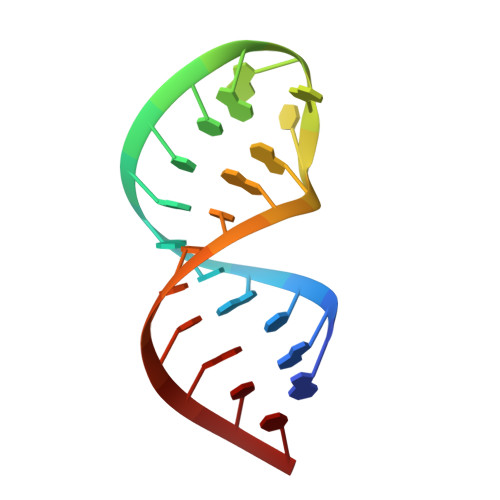Structure of an AAGU Tetraloop and its Contribution to Substrate Selection by yeast RNase III.
Gaudin, C., Ghazal, G., Yoshizawa, S., Elela, S.A., Fourmy, D.(2006) J Mol Biol 363: 322-331
- PubMed: 16979185
- DOI: https://doi.org/10.1016/j.jmb.2006.08.029
- Primary Citation of Related Structures:
2HNS - PubMed Abstract:
RNase III enzymes are a highly conserved family of proteins that specifically cleave double-stranded RNA (dsRNA). These proteins are involved in a variety of cellular functions, including the processing of many non-coding RNAs, mRNA decay, and RNA interference. In yeast Rnt1p, a dsRNA-binding domain (dsRBD) recognizes its substrate by interacting with stems capped with conserved AGNN tetraloops. The enzyme uses the tetraloop to cut 14nt to 16nt away into the stem in a ruler-like mechanism. The solution structure of Rnt1p dsRBD complexed to one of its small nucleolar (sno) RNA substrate revealed non-sequence-specific contacts with the sugar-phosphate backbone in the minor groove of the AGNN fold and the two non-conserved tetraloop nucleotides. Recently, a new form of Rnt1p substrates lacking the conserved AGNN sequence but instead harboring an AAGU tetraloop was found at the 5' end of snoRNA 48 precursor. Here, we report the solution structure of this hairpin capped with an AAGU tetraloop. Some of the stacking interactions and the position of the turn in the sugar-phosphate backbone are similar to the one observed in the AGNN loop structure; however, the AAGU sequence adopts a different conformation. The most striking difference was found at the 3' end of the loop where Rnt1p interacts with AGNN substrates. The last nucleotide is extruded from the AAGU tetraloop structure in contrast to the compact AGNN fold. The AAGU hairpin structure suggests that Rnt1p recognizes substrates with different tetraloop structures, indicating that the structural repertoire specifically recognized by Rnt1p is larger than previously anticipated.
Organizational Affiliation:
Laboratoire de RMN, ICSN-CNRS 1 ave de la terrasse, 91190 Gif-sur-Yvette France.














